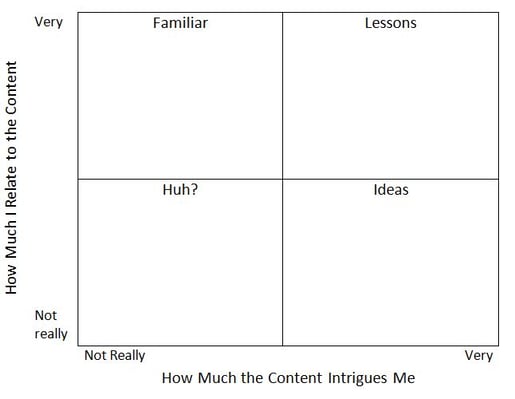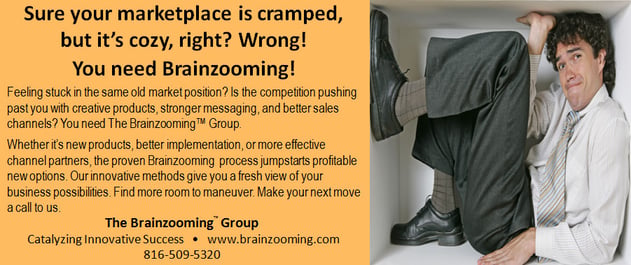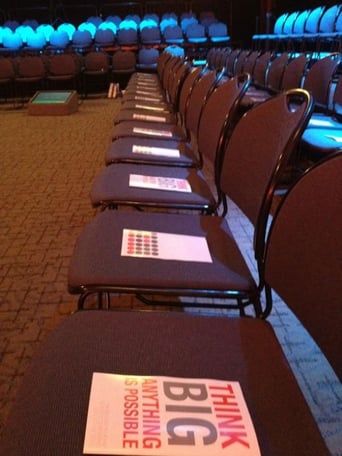I love Big Ideas.
That’s why I’m so excited about attending and speaking next week at The Big Ideas in Higher Education Conference at Rutgers University.
And in a clear departure from other higher education conference programs, even though The Big Ideas in Higher Education Conference (#BigIdeas12) is for educators, the TED-oriented and Inside the Actor’s Studio-style sessions will largely be delivered by non-educators. And having gone through the speaker bios in-depth to prepare my own session, there’s an incredible group of amazingly talented and accomplished people presenting at the two-day conference.
But Where Are the Educators at this Higher Education Conference?
 Since there’s an expectation some attendees are going to struggle with the absence of a full slate of higher education presenters, my last-afternoon session is to help attendees in capturing big ideas and making strategic connections among the various sessions so they can start making things happen with The Big Ideas in Higher Education Conference content.
Since there’s an expectation some attendees are going to struggle with the absence of a full slate of higher education presenters, my last-afternoon session is to help attendees in capturing big ideas and making strategic connections among the various sessions so they can start making things happen with The Big Ideas in Higher Education Conference content.
As I said to The Big Ideas in Higher Education Conference organizers, it would be better to do my session near the start of the conference rather than at the end. Alas, it was too late to change things around.
Instead, here are some thoughts for attendees at any conference where there are going to be speakers who may seem to have little direct connection to what you do. Even if that’s the case, there are always going to be opportunities to learn, especially from someone who knows nothing about what you know.
Capturing All Your Big Ideas and Making them Happen
Here are 3 key steps for capturing big ideas at a conference where the presenters or material are outside your focus areas:
1. List what you want from the conference beforehand.
List a few opportunities, challenges, or issues you want to address from the information presented at the conference. This will help keep your most important objectives top-of-mind throughout the conference.
2. Don’t take notes. Capture ideas and thought starters – even challenging and apparently irrelevant ones.
It’s great to take notes at a conference. But in addition, capture and keep a separate list of ideas & comments from the presenters. These are the concepts that really get you thinking, even if you don’t know what to think about them. Maybe it’s an interesting statistic. It could very well be something that connects with you on emotional level (think: excited, stunned, energized, angered, stimulated, challenged, etc.), even if it’s apathy or boredom from wondering why the presenter is sharing information you don't think connects with you.
Organize these ideas and thought starters relative to how much you relate to the information and how much the concepts intrigue you. The matrix below presents a way to organize your notes:
3. Start Making Strategic Connections
Some strategic connections between your list in number 1 and ideas / concepts shared at the conference will be naturals (“Lessons” should be directly applicable to your interests; ”Familiar” ideas may need a little creative sizzle).
Other strategic connections will be more challenging to identify, but those are often the most fruitful ones for innovation opportunities.
To help identify potential strategic connections look for the following relationships between your list and the conference ideas:
- Similarities
- Stark differences
- Shared characteristics
- Similar inputs and/or outputs among them
- Sequential relationships between items on each list
After having identified these relationships, you should be able to more easily find “Big Ideas” within the "Ideas" quadrant. This will occur as you link your related to opportunities/challenges to ideas / concepts from the conference content.
Ideas in the “Huh?” category should provide relatively fertile ground for additional brainstorming to identify innovative connections you missed seeing the first time through.
What’s Next?
These first three steps will get you started in looking at ideas shared at an innovative business conference in new ways.
What’s next in terms of additional techniques for innovatively adapting ideas to your organizational situation is the topic of my presentation for The Big Ideas in Education Conference?
Coming out of my session ("Take all of your Big Ideas and Make them Happen, an Innovation Workshop"), I’ll share multiple strategic techniques exercises to derive even greater value from an innovative conference experience.
And if you want to follow along, track The Big Ideas Education Conference on Twitter at #BigIdeas12. - Mike Brown
Subscribe for Free to the Brainzooming blog email updates.
The Brainzooming Group helps make smart organizations more successful by rapidly expanding their strategic options and creating innovative plans they can efficiently implement. Email us at info@brainzooming.com or call us at 816-509-5320 to learn how we can help you enhance your strategy and implementation efforts.





